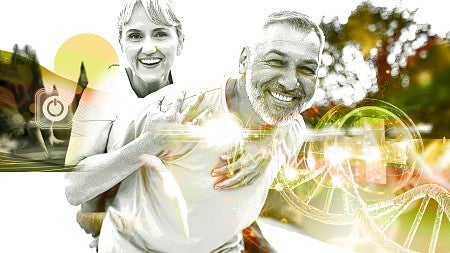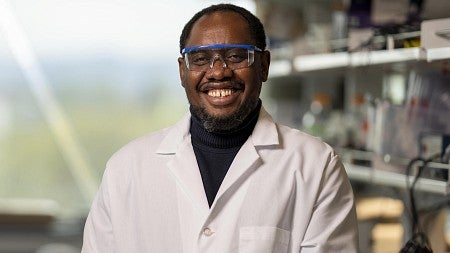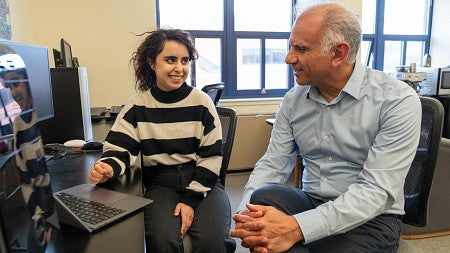
Spatial Data Science: Geography Maps a Course
Ducks trained in spatial data science are landing exciting jobs and serving humanitarian ends
By Emily Halnon • Photo by Charlie Litchfield • July 10, 2019
8 min read
The Power of Spatial Data Science
A Libyan woman cracks her front door and hears a thunderous noise erupting from somewhere deep within the besieged city of Tripoli. Another bombing, she thinks as she slinks back inside. Violence has become a constant and unpredictable part of her life, as militias and renegade forces fight for control of Libya. With tens of thousands of people displaced from their homes and hundreds of civilian casualties, this woman’s daily routine now hinges around wondering what parts of the city are safe.
“Spatial data science demonstrates how much potential there is to use computer science to address social issues”
She pulls out her phone to find answers through an application called Averto, which provides safety information from 6,500 users who are marking incidents like bombings, militia checkpoints, and shootings on the app’s digital map. The woman scans the pins dotting the map to see where threats exist—and strides out into the web of streets nestled between the desert and the Mediterranean Sea.
Geospatial Technologies at the UO
This app illustrates the kind of work that UO graduates like Alec Savoy, BS ’18, are doing with spatial data science and technology degrees from the geography department. This new offering at the UO is positioning students to land jobs with top employers and to offer innovative solutions to social, economic, environmental, and humanitarian questions—like how to help people stay safe in volatile regions.
“Spatial data science demonstrates how much potential there is to use computer science to address social issues,” Savoy says. That’s what hooked him on the major and motivated him to volunteer his programming skills to help develop Averto, a venture spearheaded by UO seniors Harley Emery and Alex Mentzel, with key support from the Lundquist Center for Entrepreneurship in the form of networking, business resources, and more.
Averto is not Savoy’s first crack at using technology to solve problems. While he was at the UO, Savoy pursued a project that aimed to clean up streets by incentivizing users to remove litter. And he created an app from scratch called Informer, designed to text emergency alerts to people in regions where smartphones are rare but many still have cellphones. It was through his work designing Informer that he met the founders of Averto.
Creating Apps and Making Maps
The idea of creating new digital tools and technology is planted on the very first day of Our Digital Earth, one of the course requirements for the major.
“We’re not going to use Google Earth, we’re going to teach you how to make it,” Professor Amy Lobben tells her students. “To simply use location-based services is to be the customer. What’s really empowering is to be able to make the app.”
The major draws from geography, computer science, and math to consider how location-based data and technologies can be leveraged across public policy, consumer technology, and disaster relief—to name a few of the discipline’s countless applications.
“Spatial data is everywhere, it’s harder to say where it isn’t,” says Lobben. She explains that this booming field is integral in everything from Google maps to self-driving cars to tracking climate change to finding the best path from Condon Hall to the EMU.
“Everyone who has a smartphone uses location-based data services, they’re almost ubiquitous in our society,” says Lobben. “Yet most schools weren’t seeing spatial data science as a valuable academic pursuit.”
Faculty members saw this gap as an opportunity to put the UO on the map and established the major in 2017.
Lauren Tierney, BA ’12, MS ’15 (geography), exemplifies why the UO made this move. Tierney is one of several geography alumni who have converted skills honed through the department into promising careers with the Washington Post and the New York Times, Apple, National Geographic, Google, the United Nations, and other prominent government organizations, media entities, and tech firms.
“We have so many geography alumni doing incredible work in this field, they definitely helped inspire the conception of this major,” says faculty advisor Leslie McLees. She proudly rattles off a list of alumni jobs with the ease of reciting her ABCs.
The ability to communicate powerful stories through data-driven maps and graphics hooked Tierney as a student. She was inspired after taking a course in geographic information systems, a pillar of the data science field that focuses on creating digital maps and other visuals.
“I realized how you can use mapping tools and software to explain what’s going on in the world,” she says. Tierney spent three years in the UO InfoGraphics Lab, getting hands-on experience making maps and generating graphics for projects like the lab’s award-winning atlases.
Tierney began her career at National Geographic before scoring her current job at the Washington Post, where she’s a graphics reporter and cartographer. She spends her work days turning big data sets into digestible visuals to help enhance storytelling for readers.
One of Tierney’s first projects for the newspaper giant illustrates how data visualization can educate the public on a complex subject. Her assignment was to help communicate the gravity of the California wildfires in 2017, then the most destructive fire season in the state’s history.
Tierney’s article opens with a grim graphic that includes dozens of ashen-hued outlines which mirror the boundaries of the season’s biggest fires, and the cluster of flames engulf a sketch of the District of Columbia that seems miniscule in comparison. It’s a shocking sight that clearly illustrates the magnitude of the state’s largest blazes.
“I thought comparing the shapes of the fires to the size of DC would help people visualize the enormous devastation and scale of the fire season,” she says. “It’s so powerful to be able to communicate science and research in ways that people can easily understand and connect with.
“Am I talking too fast?” Tierney asks. “I just get so excited about this stuff.”
For another story, she traveled to the sunbaked desert of southeastern Utah to document how the Bears Ears National Monument has been reduced under the Trump administration. The project relied on drone technology to give viewers a 3-D tour of the cliff dwellings, rock tower, and petroglyphs that have been cut from protection.
Before the trip west, Tierney underwent training to learn the ins and outs of drone technology—that’s now a course under the new major.
These examples of data visualization and modeling are among the paths that UO students can pursue in the new major. Others include data collection and management, spatial analysis, and computer programming.
Responding to Natural and Humanitarian Disasters with Spatial Data Science
The desire to harness these spatial data skills and technologies into humanitarian work is widespread among faculty members, students, and graduates in spatial data science.
Josie Imrie, BS ’18 (geography), notes this as she shares her professional and academic experience from a sunny patio in south Eugene, where she works remotely for a tech startup based out of San Francisco.
“We all care about what’s going on in the world around us,” she says.
Imrie works for Enview, which identifies threats to critical energy infrastructure, such as vegetation too close to power lines, before they escalate into incidents that could jeopardize property and lives. The group relies on technology called light detection and ranging (LIDAR); this airborne technology is based on harmless rapid laser pulses shot from sensors on airplanes to detect features in the earth’s surface.
It was at the UO that Imrie first appreciated that spatial data and mapping tools could be critical resources in the wake of natural and humanitarian disasters. In one class, Imrie and fellow students learned how emergency responders used a digital “crisis map” incorporating social media data and satellite imagery after a 7.0 earthquake devastated Haiti and left millions stranded without power or supplies. That crisis map sold Imrie on spatial data science.
“As our environment is changing, natural disasters are becoming more and more prevalent,” Imrie says. “The United States is not doing enough. I want to use my degree to make an impact and help address this shortcoming.”
An Academic Path to Countless Career Opportunities
Arielle Alferez, a geography major and graduating senior with the class of 2019, is also using the field to improve lives by creating 3-D tactile maps to serve people who are blind; these handheld maps allow people with visual impairments to feel important features in a building or landscape, such as staircases, trees, and sidewalks.
Alferez teamed up with Lobben to produce these maps for buildings on campus and a local ski resort.
“How does someone who’s blind find their way around a new space with many different physical features?” she asks.
Alferez has volunteered for years with Oregon Adaptive Sports (OAS), whose focus is to increase outdoor recreation for people with disabilities. After she started working with Lobben, Alferez proposed making a tactile map to help visually impaired skiers and snowboarders navigate the 800 acres and 34 runs at Hoodoo Ski Area, which hosts ski lessons for OAS throughout the winter.
To do this, Alferez digitized features such as the hundreds of trees that skirt the runs and the five lifts that speed up the mountain. Her tactile map will be ready to help blind skiers find their way around the mountain next winter.
Alferez notes spatial data science’s potential application in areas ranging from conservation to sustainability to managing public resources and land. The seemingly limitless possibilities and the marketable degree lured Alferez into the major.
“I knew I could walk out of college and have a tangible skill,” she says. “There are so many opportunities with this degree.”
Emily Halnon is a staff writer for University Communications.




